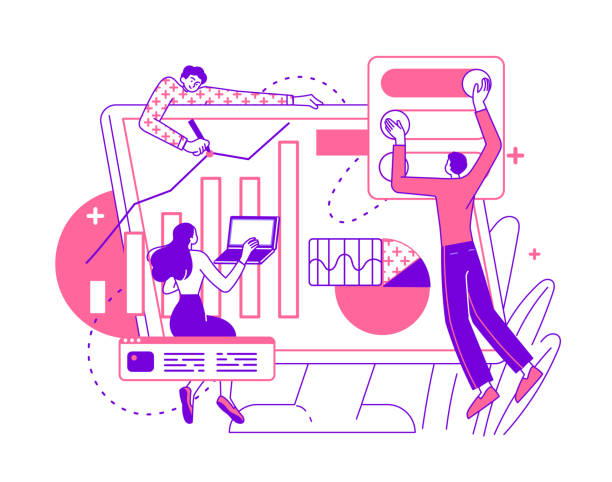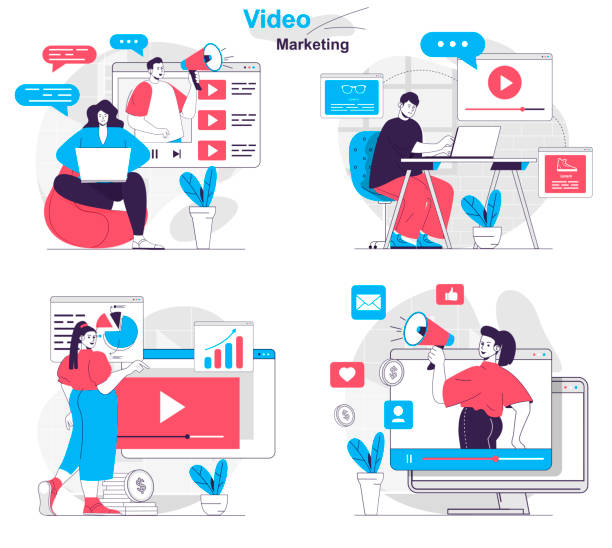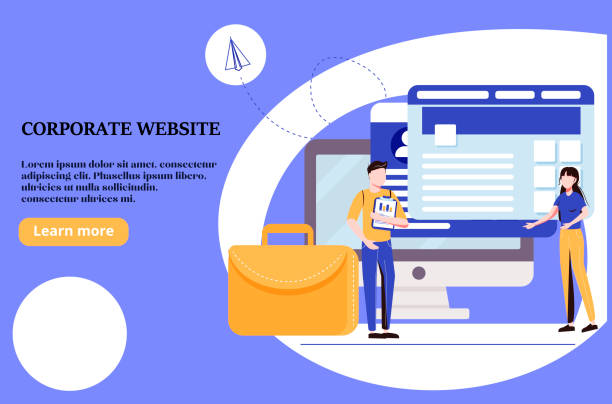The Importance of Speed in Modern Website Design

In today’s world, where internet speed and access to information are paramount, fast website design is not just an advantage, but an undeniable necessity.
Websites that load slowly not only create an unpleasant user experience but can also severely harm businesses.
Research has shown that even a one-second delay in page load time can lead to a significant decrease in #conversion_rate and an increase in visitor #bounce_rate.
Today’s users are more impatient than ever and expect web pages to load instantly.
This is especially important on mobile devices, which may not have a stable internet connection.
A slow website can lead to lost potential customers, reduced revenue, and even damage to your brand’s reputation.
Therefore, focusing on fast website design and optimizing its performance should be a priority in any digital marketing strategy.
This is not just a technical discussion; it directly impacts commercial success and customer satisfaction.
Speed optimization includes various aspects, from choosing suitable hosting to optimizing images and website code.
Are you frustrated with the low conversion rate of your online store?
Rasaweb, with professional e-commerce website design, is your definitive solution!
✅ Increase your sales and revenue
✅ Provide an unparalleled user experience for your customers
⚡ Get a free consultation now!
Key Factors Affecting Load Speed

To achieve fast website design, understanding the factors affecting load speed is essential.
The first and most important factor is server response time.
A slow server or unsuitable hosting can severely reduce website load speed, even if the site content is optimized.
The second factor is the size of website files.
High-volume images, bulky JavaScript and CSS files, and unoptimized videos can all increase load time.
Compressing these files and using appropriate formats for images are highly important.
The third factor is the number of HTTP requests that the browser must send to the server to fully load the page.
The fewer these requests, the faster the load speed will be.
This includes CSS files, JavaScript, images, and fonts.
Optimizing coding and combining files can be helpful in this regard.
The fourth factor is the lack of proper Caching.
Caching allows the browser to store versions of website files so that they do not need to be reloaded on subsequent visits.
This approach provides a much better user experience, especially for users who visit the site frequently.
These factors together are the ultimate determinants of website load speed, and special attention must be paid to each of them for fast website design.
Optimizing Images and Media for Speed Increase

Images and media files typically constitute the largest portion of a web page’s size, and therefore, their optimization plays a vital role in fast website design.
The first step in this path is choosing the correct image format.
For high-quality photos with many details, JPEG format is suitable, while for graphics and icons with transparency, PNG is a better choice.
Newer formats like WebP can offer similar quality with much smaller file sizes, and their use is highly recommended.
After choosing the format, compressing images without noticeable quality loss is the next step.
Online tools and CMS plugins like WordPress can easily perform this task.
Also, resizing images to their actual display dimensions on the page prevents loading images larger than needed.
Using “Lazy Loading” for images and videos is also very effective.
With this method, images are only loaded when the user scrolls to the relevant section of the page, which significantly improves initial load speed, especially for long pages with many images.
Don’t forget that adding width and height attributes to image tags can prevent layout shifts and provide a better user experience.
These actions collectively help create a faster and more efficient website.
| Format | Recommended Use Cases | Advantages | Disadvantages |
|---|---|---|---|
| JPEG | Complex photos, images with many colors | Excellent compression, small file size | No transparency support, quality loss with high compression |
| PNG | Logos, icons, images with transparency | Transparency support, image quality preservation | Larger file size compared to JPEG for photos |
| WebP | All types of images | Very high compression, transparency and animation support | Incomplete support by older browsers |
| SVG | Vector graphics, icons, charts | Infinite scalability without quality loss, small file size | Only suitable for vector graphics |
Optimizing Website Code and Files

One of the main pillars in achieving a fast website design is optimizing website coding and files.
The first step in this regard is minification of CSS, JavaScript, and HTML files.
This process involves removing extra characters such as white spaces, new lines, and comments from the code, which reduces file size and speeds up loading time.
Using automated tools for this is highly recommended.
The next step is to compress files using Gzip or Brotli.
These protocols can reduce the size of text files by up to 70%, which has a significant impact on loading speed.
Also, special attention should be paid to eliminating Render-Blocking Resources.
JavaScript and CSS files placed in the head section of the page can prevent the main page content from rendering.
By moving JavaScript to the end of the body and using async or defer attributes for scripts, this problem can be resolved.
Optimizing CSS by removing unused CSS (PurgeCSS) and combining smaller CSS files into one larger file can also be beneficial.
Proper management of web fonts, including loading subsets and using font-display: swap, also helps improve speed.
All these measures move towards a faster and more efficient website design.
Is your current e-commerce website design causing you to lose customers and sales?
Rasaweb, with modern and user-friendly e-commerce website designs, is your solution!
✅ Significant increase in conversion rates and sales
✅ Strong branding and building customer trust
⚡ Get a free e-commerce website design consultation from Rasaweb!
The Role of Hosting and CDN in Website Speed

Choosing suitable hosting and using a Content Delivery Network (CDN) are two vital elements in achieving fast website design.
Website hosting is essentially the home where your site’s files are stored.
The quality of this home directly impacts server response time.
Shared hosting, though cheaper, shares server resources with a large number of websites, which can lead to reduced speed during peak hours.
In contrast, Virtual Private Servers (VPS) or dedicated servers provide you with more resources and are a more suitable option for websites with high traffic or a need for very good performance.
Cloud Hosting, by offering high flexibility and scalability, can also help maintain speed under varying traffic conditions.
Alongside hosting, CDN (Content Delivery Network) is a powerful technology for increasing load speed, especially for users from distant geographical locations.
By storing copies of your website’s static content (such as images, CSS, and JavaScript) on multiple servers located around the world, CDN ensures that content is delivered from the server closest to the user.
This significantly reduces latency and improves user experience.
Using a CDN not only increases speed but also helps with website security and stability by distributing the traffic load.
Therefore, for any fast website design strategy, optimizing hosting and implementing a CDN are high priorities.
Caching Strategies for Superior Performance

Caching is one of the most effective methods for improving website load speed and achieving fast website design.
Caching means temporarily storing data in a location closer to the user or server, to reduce access time for subsequent requests.
There are different types of caching, each playing an important role in optimizing website performance.
Browser Caching allows the user’s browser to store static website files (such as images, CSS, and JavaScript) in its local memory.
This means that on subsequent visits to the same site, the browser does not need to re-download these files from the server, which significantly increases load speed.
Server-Side Caching is also highly important.
This type of caching can include Page Caching, Object Caching, and Database Caching.
Full-page caching stores a version of the final HTML page so that it does not need to be reprocessed by the server on subsequent requests.
This is particularly useful for dynamic websites that use Content Management Systems (CMS) like WordPress.
Many popular caching plugins like WP Super Cache or W3 Total Cache easily offer these capabilities.
Using CDN caching, as mentioned in the previous section, adds another layer of optimization.
By correctly implementing caching strategies, website load time can be dramatically reduced, providing a smoother user experience, all moving towards fast website design.
Responsive Design and Mobile Load Speed

In the current era, where most users access the internet via mobile devices, fast and responsive website design for mobile is of particular importance.
Google has also explicitly stated that mobile load speed is one of the key factors in search result rankings (Mobile-first indexing).
A responsive website automatically adjusts its layout and content to the user’s device screen size, but simply being responsive does not guarantee speed.
To achieve fast website design on mobile, more specialized points must be considered.
Firstly, image optimization for mobile is crucial.
Using images with appropriate resolution for smaller screens and further compressing them can significantly reduce page size.
Secondly, reducing unnecessary JavaScript scripts and CSS files that can be heavy on mobile devices is essential.
Mobile-First Design means starting the design and development process for mobile devices first and then extending it to larger screens.
This approach helps us apply the necessary optimizations for speed and efficiency on mobile from the outset.
Additionally, considering lower bandwidth in mobile networks (such as 3G or 4G) and optimizing for poor connection conditions can dramatically improve the user experience.
Implementing Accelerated Mobile Pages (AMP) can also be an option for ultra-fast page loading on mobile, although it has its own considerations.
Overall, attention to detail in fast website design for mobile is the key to success in today’s digital world.
| Factor | Desktop | Mobile |
|---|---|---|
| Average Internet Speed | Higher (Broadband) | Variable (3G/4G/5G) |
| Device Processing Power | Usually higher | Usually lower |
| Screen Size | Larger | Smaller |
| Optimization Recommendation | High-quality images, custom fonts | Optimized images, system fonts or few custom fonts |
| Main Goal | Rich visual experience | Speed, accessibility, ease of use |
Website Speed Monitoring and Testing Tools and Methods

After implementing fast website design techniques, the next step is continuous monitoring and testing of website performance.
This helps you identify potential problems and make further optimizations.
There are numerous tools for testing website speed, each providing valuable information.
Google PageSpeed Insights is one of the most popular and important tools, giving your website a score between 0 and 100 for desktop and mobile speed, and also offering suggestions for improvement.
This tool also evaluates Core Web Vitals, which are Google’s ranking factors.
GTmetrix is another powerful tool that provides precise details about load time, number of requests, page size, and overall performance.
This tool also uses Waterfall reports, which help you see which resources take the longest to load.
Pingdom Tools offers similar functionality and allows you to test your site’s speed from various geographical locations.
In addition to these external tools, using browser developer tools like Chrome DevTools is also very useful for real-time performance checking.
By using the Network tab in these tools, you can view individual HTTP requests and identify bottlenecks.
Continuous monitoring and analysis of reports from these tools help you keep your website at peak performance at all times and ensure that your fast website design strategy is correctly implemented and yields desired results.
Are you tired of your e-commerce website not generating as much revenue as it could? Rasaweb, specializing in professional e-commerce website design, solves this problem forever!
✅ Increase sales rate and revenue
✅ High load speed and unparalleled user experience
⚡ Get a free e-commerce website design consultation
Seamless User Experience with Fast Website Design

The topic of fast website design goes beyond merely reducing load time; it is directly related to a seamless User Experience (UX).
Did you know that users decide whether to stay on your website in less than three seconds? Speed is the first, and perhaps most important, factor influencing this decision.
A slow website can lead to user frustration, an increased Bounce Rate, and consequently, lost business opportunities.
In contrast, a website that loads quickly conveys a sense of professionalism and credibility to the user.
Users feel that you value their time, and this builds their trust.
High speed also allows users to easily navigate between pages and find their desired content without delay, which in turn leads to an improved Conversion Rate.
For example, in an online store, every millisecond of delay can mean a lost sale.
This is not just about fast web design, but a comprehensive strategy for customer retention and acquisition.
A fast website gives users the feeling that they have more control over their online experience and can easily achieve their goal, whether it’s purchasing a product, reading an article, or filling out a form.
This psychological aspect of speed is often overlooked, but ultimately, it has a profound impact on customer loyalty and business growth.
Therefore, any investment in fast website design is an investment in improving user experience and increasing customer satisfaction.
Future Trends in Fast and Optimized Website Design

The world of web development is constantly evolving, and with the emergence of new technologies, the concept of fast website design is also changing.
One of the most important future trends is the widespread adoption of the HTTP/3 protocol.
This new generation of the HTTP protocol, built on QUIC, promises unprecedented load speeds by reducing latency and improving performance on unstable networks.
With broader browser and server support, HTTP/3 is expected to become the new standard for data transfer on the web.
Another trend is the increasing popularity of Progressive Web Apps (PWAs).
PWAs are websites that offer native app capabilities such as offline access, Push Notifications, and home screen icons to users, while retaining their web nature.
This technology, by reducing initial load time and enabling a very smooth user experience, will play an important role in fast website design.
Additionally, the use of WebAssembly for executing high-performance code in the browser allows developers to implement more complex and faster applications directly on the web.
Artificial intelligence and machine learning will also play an increasing role in optimizing websites, from predicting user-needed content for earlier loading to automatic optimization of images and code.
Ultimately, with increasing demand for instant and delay-free online experiences, the focus on fast website design will not only continue but will move towards a point where any delay in page loading is considered unacceptable.
These developments show that speed optimization is a continuous and unending process.
Frequently Asked Questions
| Question | Answer |
|---|---|
| What is fast website design? | The process of building websites that load quickly. |
| Why is website speed important? | It improves user experience, positively impacts SEO, and increases conversion rates. |
| What factors affect site load speed? | Server speed, image size, code optimization, browser caching. |
| How can website speed be increased? | Optimizing images, compressing CSS and JavaScript files, using a CDN, and choosing suitable hosting. |
| What are the common tools for site speed testing? | Google PageSpeed Insights, GTmetrix, Pingdom Tools. |
| Does server geographical location affect speed? | Yes, less distance between the user and the server leads to less latency and faster speed. |
| What does image optimization mean? | Reducing the file size of images without significant reduction in their quality. |
| What is browser caching and how does it help with speed? | Temporarily storing website resources (like images, CSS, and JS files) in the user’s browser for faster loading on subsequent visits. |
| What is the impact of site speed on SEO? | Google considers site speed as a ranking factor; faster sites usually achieve a better ranking. |
| How can CSS and JavaScript files be optimized? | By minification and concatenation of files to reduce size and number of requests. |
And other services of Rasaweb Advertising Agency in the field of advertising
Smart Content Strategy: Transform click-through rates with Google Ads management.
Smart Marketplace: A fast and efficient solution for campaign management focusing on marketing automation.
Smart SEO: A quick and effective solution for online growth focusing on the use of real data.
Smart Digital Branding: An effective tool for digital branding with the help of attractive UI design.
Smart Advertising Campaign: Designed for businesses seeking digital branding through user experience customization.
And over hundreds of other services in the field of internet advertising, advertising consultation, and organizational solutions
Internet Advertising | Advertising Strategy | Advertorial
Resources
Comprehensive Guide to Website Speed Optimization
Increase WordPress Speed: Key Tips
Best Practices for Web Performance Improvement
The Impact of Page Speed on Website SEO
? To reach the pinnacle of success in the digital world, Rasaweb Afarin is by your side with professional responsive website design and digital marketing services.
📍 Tehran, Mirdamad Street, next to Central Bank, Southern Kazeroun Alley, Ramin Alley, No. 6



